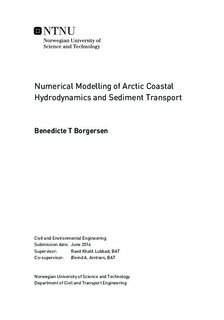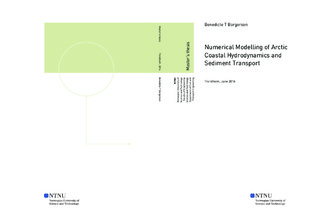Numerical Modelling of Arctic Coastal Hydrodynamics and Sediment Transport
| dc.contributor.advisor | Lubbad, Raed Khalil | |
| dc.contributor.advisor | Arntsen, Øivind A. | |
| dc.contributor.author | Borgersen, Benedicte T | |
| dc.date.accessioned | 2016-09-06T14:00:41Z | |
| dc.date.available | 2016-09-06T14:00:41Z | |
| dc.date.created | 2016-06-09 | |
| dc.date.issued | 2016 | |
| dc.identifier | ntnudaim:15771 | |
| dc.identifier.uri | http://hdl.handle.net/11250/2404714 | |
| dc.description.abstract | Coastal areas are experiencing an increase in human population and activities, both in temperate and in Arctic areas. This change in the coastal areas requires that the areas are safe and reliable in order to not put human lives and economical values in danger. To be about to protect the coastal areas it is important to know the hydrodynamics and sediment transport and their effect on coastal areas. Numerical modeling of coastal hydrodynamics and sediment transport is a normal approach to evaluate coastal engineering problems. Many numerical modeling tools are developed for temperate areas but there are not so many programs developed to investigate the Arctic coastal erosion. This thesis written at Norwegian University of Science and Technology(NTNU) is researching Bjørndalen at Svalbard and the coastal erosion that took place because of the storm in 2015. This study investigates the possibility to model the hydrodynamics in an Arctic area and further to be able to use a numerical modeling tool to investigate the Arctic coastal erosion. The numerical tool used in this thesis is MIKE21 developed by Danish Hydraulic Institute(DHI). MIKE21 is a coastal modelling program developed to be used in coastal and marine environments. The results of modelling the coastal hydrodynamics in Isfjorden where Bjørndalen is located is not perfect and they have some unrealistically errors in the results. Bjørndalen is located at a site where the lack of measured data makes it difficult to calibrate the model. In this case the model was not calibrated as it should have been. This study will be a beginning to be able to predict the evolution of out coastal zones in the Arctic. Hopefully it will be found ways to predict coastal erosion in the Arctic, which in turn will make it possible to protect the coast from damage. | |
| dc.language | eng | |
| dc.publisher | NTNU | |
| dc.subject | Bygg- og miljøteknikk, Marin byggteknikk | |
| dc.title | Numerical Modelling of Arctic Coastal Hydrodynamics and Sediment Transport | |
| dc.type | Master thesis | |
| dc.source.pagenumber | 92 |

